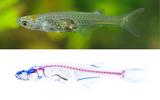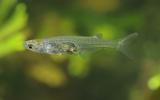Their miniature size and simplified anatomy combined with a highly specialized communication system make the fish of the genus Danionella an important model organism for neuroscientific studies. The reason is that with the crystal danios, which are only between 11 and 17 millimetres in size, the brain functions of adult animals can be studied at the cellular level. «The reductive morphological structure of these fishes poses a serious problem for taxonomists, as they have lost many features otherwise used to distinguish fish species. However, for a research model, to know the correct species identity is crucial» explains Dr Lukas Rüber from the Natural History Museum Bern.
Rüber and his colleagues Ralf Britz from the Senckenberg Natural History Collections Dresden and Kevin Conway from Texas A&M University have now described a new species of the genus. «Using genetic studies combined with classical, taxonomic methods, we were able to show that the fish species studied in several laboratories internationally and referred to as Danionella translucida is actually a previously unknown species», adds Rüber.

Ralf Britz/Senckenberg Naturhistorische Sammlungen Dresden
The newly discovered crystal danio species has a maximum length of 13.5 millimetres and has a restricted distribution in Myanmar. The Bernese ichthyologist explains: «Our genetic studies have demonstrated that there is only a distant relationship between the true D. translucida and our new species. In their external appearance, however, the two species are almost indistinguishable, which makes it more problematic as they occur at the same localities».
The international team has therefore given the small fish a new scientific name and described its anatomy in detail. The new species name Danionella cerebrum, with the addition of cerebrum, Latin for «brain», draws attention to the fact that the fish has one of the smallest known vertebrate brains and is also used in brain research as a model organism.
Scientific Report by Ralf Britz, Kevin W Conway and Lukas Rüber: The emerging vertebrate model species for neurophysiological studies is Danionella cerebrum, new species (Teleostei: Cyprinidae).
Update from March 2024:
A German research team from Germany has discovered that the small fish can produce sounds of up to 140 dB with their mini brains. This is equivalent to the volume of an airplane take-off. Click here for the study.



